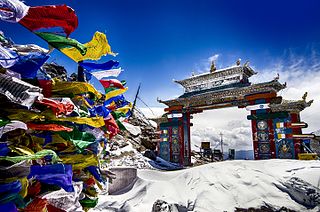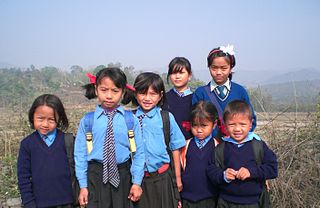Related Research Articles

Northeast India, officially known as the North Eastern Region(NER) is the easternmost region of India representing both a geographic and political administrative division of the country. It comprises eight states—Arunachal Pradesh, Assam, Manipur, Meghalaya, Mizoram, Nagaland and Tripura (commonly known as the "Seven Sisters"), and the "brother" state of Sikkim.

The Meitei people, Meetei people, or Manipuri people is an ethnic group native to Manipur. They form the largest and dominant ethnic group of Manipur in Northeast India. They speak the Meitei language, one of the 22 official languages of the Indian Republic and the sole official language of Government of Manipur. The Meiteis primarily settled in the Imphal Valley region in modern-day Manipur, though a sizeable population has settled in the other Indian states of Assam, Tripura, Nagaland, Meghalaya, and Mizoram. There is also a notable presence of Meitei people in the neighbouring countries of Myanmar and Bangladesh. The Meitei ethnic group represents about 53% of Manipur's population.

Central Agricultural University is an agricultural university at Lamphelpat, Imphal in the Indian state of Manipur.

The following outline is provided as an overview of, and topical guide to, India:
Here is a list of glossary of Culture of India in alphabetical order:
This article details the 2013-14 Santosh Trophy qualifiers.
This article details the 2015 Santosh Trophy qualifiers.

Northeast India consists of the eight states Arunachal Pradesh, Assam, Manipur, Meghalaya, Mizoram, Nagaland, Sikkim and Tripura. Tourism in this area is based around the unique Himalayan landscape and culture distinct from the rest of India.
This article details the 2016 Santosh Trophy qualifiers.
The North-East Democratic Alliance is a political coalition that was formed on May 24, 2016, by Bharatiya Janata Party. The motive of the new political front was to protect the interest of the people of the region as well as uniting non-Congress parties in Northeast India. Himanta Biswa Sarma was appointed as the convenor of the front.
The 2016–17 Santosh Trophy qualifiers are the qualifiers for the 2016–17 Santosh Trophy. All the teams participating in the qualifiers are divided into five zones based on where they are based and each zone is divided into two groups each.
The 2018–19 Vijay Hazare Trophy was the 17th season of the Vijay Hazare Trophy, a List A cricket tournament in India. It was contested by the 37 domestic cricket teams of India, with nine teams in the Plate Group. The group stage was started on 19 September 2018, with the top team from the Plate Group progressing to the quarter-finals of the competition.
The 2019 Santosh Trophy qualifiers was the qualifying round for the 73rd edition of the Santosh Trophy, the premier competition in India for teams representing their regional and state football associations.

The hill tribes of Northeast India are hill people, mostly classified as Scheduled Tribes (STs), who live in the Northeast India region. This region has the largest proportion of scheduled tribes in the country.
The 2021–22 Vijay Hazare Trophy was the twentieth season of the Vijay Hazare Trophy, a List A cricket tournament that was played in India. It was contested by 38 teams, divided into six groups, with eight teams in Plate Group. The tournament was announced by the BCCI on 3 July 2021. Tripura won the Plate Group to advance to the preliminary quarter-finals.
The 2021–22 Syed Mushtaq Ali Trophy was the fourteenth season of the Syed Mushtaq Ali Trophy, a Twenty20 cricket tournament played in India. It was contested by 38 teams, divided into six groups, with eight teams in Plate Group. The tournament was announced by BCCI on 3 July 2021.

Loyalakpa, also spelt as Loyarakpa, is a God in Meitei mythology and religion of Ancient Kangleipak. He is best known for wrestling with Khoriphaba during the Lai Haraoba festival. He is the consort of goddess Thoudu Nungthel Leima. He is one of the ten kingly gods in Meitei religion.
Simlabari, also known as Simlubari, is a census village in Baksa district, Assam, India. As per the 2011 Census of India, the Simlabari village has a total population of 4,357 people including 2,206 males and 2,151 females with a literacy rate of 54.56%.
Maneybung, also spelled as Maneybong, is a village in West Sikkim district, Sikkim, India. As per the 2011 Census of India, the Maneybung village has a total population of 3,407 peoples with a literacy rate of 71.18%. The Maneybung village is governed by the Maneybung-dentam assembly constituency and the Sikkim parliamentary constituency.
References
- ↑ Singh, Ch Manihar (1996). A History of Manipuri Literature. Sahitya Akademi. ISBN 978-81-260-0086-9.
- ↑ North East India History Association. Session (1995). Proceedings of North East India History Association. The Association.
- ↑ Bezbaruah, Madan Prasad (2003). Fairs and Festivals of India: Bihar, Jharkhand, Orissa, West Bengal, Arunachal Pradesh, Assam, Manipur, Meghalaya, Mizoram, Nagaland, Sikkim, Tripura. Gyan Publishing House. ISBN 978-81-212-0812-3.
- ↑ Bahadur, Mutua (1988). Jewelleries of Manipur. Mutua Museum.
- ↑ Fifth North Eastern Literary Conference, 8th, 9th & 10th January 1994, Agartala, Tripura [souvenir]. The Conference. 1994.
- ↑ Parratt, Saroj Nalini (1997). The Pleasing of the Gods: Meitei Lai Haraoba. Vikas Publishing House. ISBN 978-81-259-0416-8.
- ↑ Tensuba, Keerti Chand (1993). Genesis of Indian Tribes: An Approach to the History of Meiteis and Thais. Inter-India Publications. ISBN 978-81-210-0308-7.
- ↑ Singh, Moirangthem Kirti (1998). Recent Researches in Oriental Indological Studies: Including Meiteilogy. Parimal Publications.
- 1 2 Ahluwalia, B.K. (1984). Social Change in Manipur. Cultural Publishing House.
- ↑ Kabui, Gangmumei (2004). The History of the Zeliangrong Nagas: From Makhel to Rani Gaidinliu. Spectrum Publications. ISBN 978-81-87502-76-0.
- ↑ Yanao Lungharnao Roland Shimmi (1988). Comparative History of the Nagas, from Ancient Period Till 1826. Inter-India Publications. ISBN 978-81-210-0210-3.